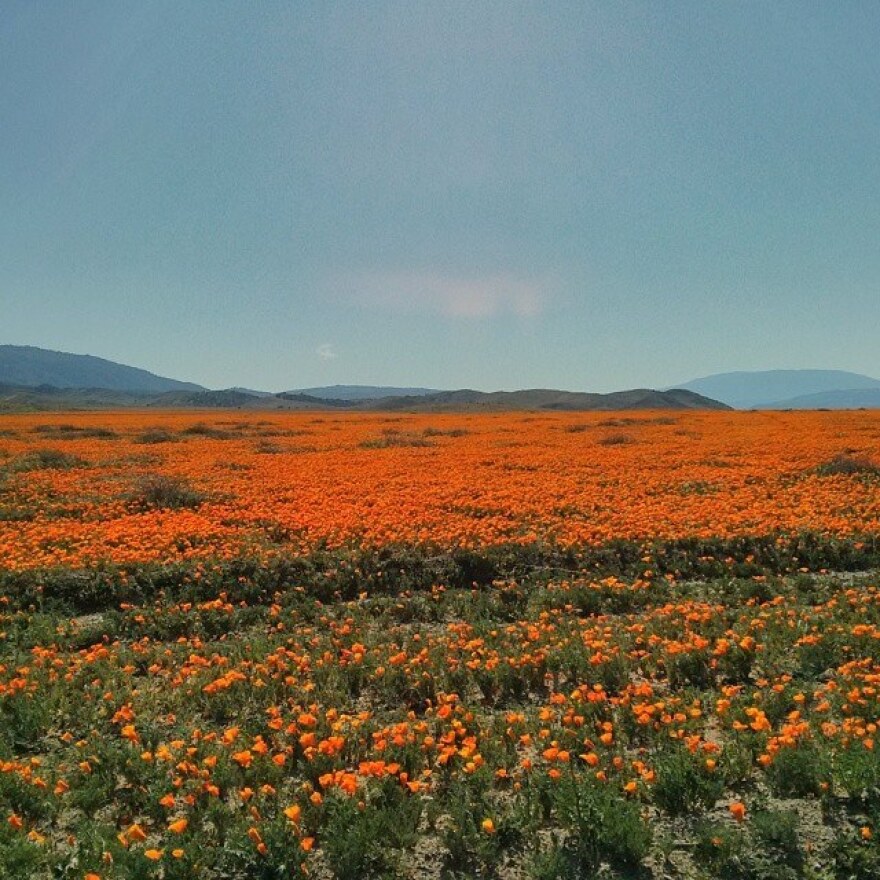Truth matters. Community matters. Your support makes both possible. LAist is one of the few places where news remains independent and free from political and corporate influence. Stand up for truth and for LAist. Make your year-end tax-deductible gift now.
This archival content was originally written for and published on KPCC.org. Keep in mind that links and images may no longer work — and references may be outdated.
Why is the California Poppy the state flower? (Q&A)

This weekend, April 26-27, Lancaster hosts its annual California Poppy Festival.
The iconic orange-gold flowers are blooming nicely this year thanks to a few rain showers this spring.
It's been called "golden poppy" and "California sunlight", but its scientific name is Eschscholzia californica.
Related: Free weekend? Pics with poppies, bowling with Lebowski and cleaning the LA river
So how exactly did California's love affair with the poppy begin and what makes it special? Here are answers to some commonly asked questions.
How did the California Poppy become the state flower?
In 1890 the California State Floral Society held an election to determine the state's signature flower.
The contestants were the Mariposa Lilly, the Matilija Poppy and the frontrunner, a plant already known as the California Poppy.
“According to all reports, it smashed its opposition,” Char Miller, director of the environmental analysis program at Pomona College, said about the California Poppy.
It took more than a decade for the legislature to make the title official. In 1903 the California Poppy became the state flower. April 6 is also dubbed California Poppy Day.
How does it survive so well in the harsh desert?
Southern California's desert environment can be a tough place for plants.
Sometimes there is very little water, other times the ground is soaked by flash floods. Harsh winds and blazing sun are a staple of the region.
The California Poppy copes with this thanks to its vast and deep root structure, says Miller.
"That allows it to sort of dig deep into these very treacherous soils that don’t look like they have a lot of nutrients."
Once deep in the ground, he explains, the poppy is able to find the nutrients it needs.
Its seeds also lay dormant in the soil during dry years, says Dr. Giles Waines, the director of UC Riverside’s Botanic Gardens.
"Then they germinate when there is enough rain," he explained.
Why does the California Poppy sometimes close its petals?
If you've been to the Antelope Valley California Poppy Reserve on a particularly cold or windy day in the spring, you may have seen the flower with closed petals.
This is a defense mechanism, says Waines. It's a common technique some flowers use in harsh conditions to protect their reproductive organs such as the stamens and ovary.
"If someone tries to kick you in the groin, you'd double up and protect yourself," he noted.
Flowers are doing the same thing, he says, by closing their petals during wind storms or chilly evenings.
Where can I see the California Poppy?
- The Antelope Valley Poppy Reserve is a perfect place to see the state flower. It's open sunrise to sunset. You can find out more about the reserve and read the latest Wild Flower Bloom Status on the park's website.
- April 26 and April 27 Lancaster will host the annual California Poppy Festival. At the Lancaster Museum/Art Gallery, visitors can pick up free wildflower maps to learn about the best viewing locations in the region. There will also be music, food and plenty of family friendly activities.
- The Los Angeles Arboretum is growing California Poppies as part of its Wildflowering LA program. An acre of grass was removed last fall to allow native wildflowers to take over. In addition to the poppies, visitors might see clarkias, lupine, yarrow, and needle grass.







